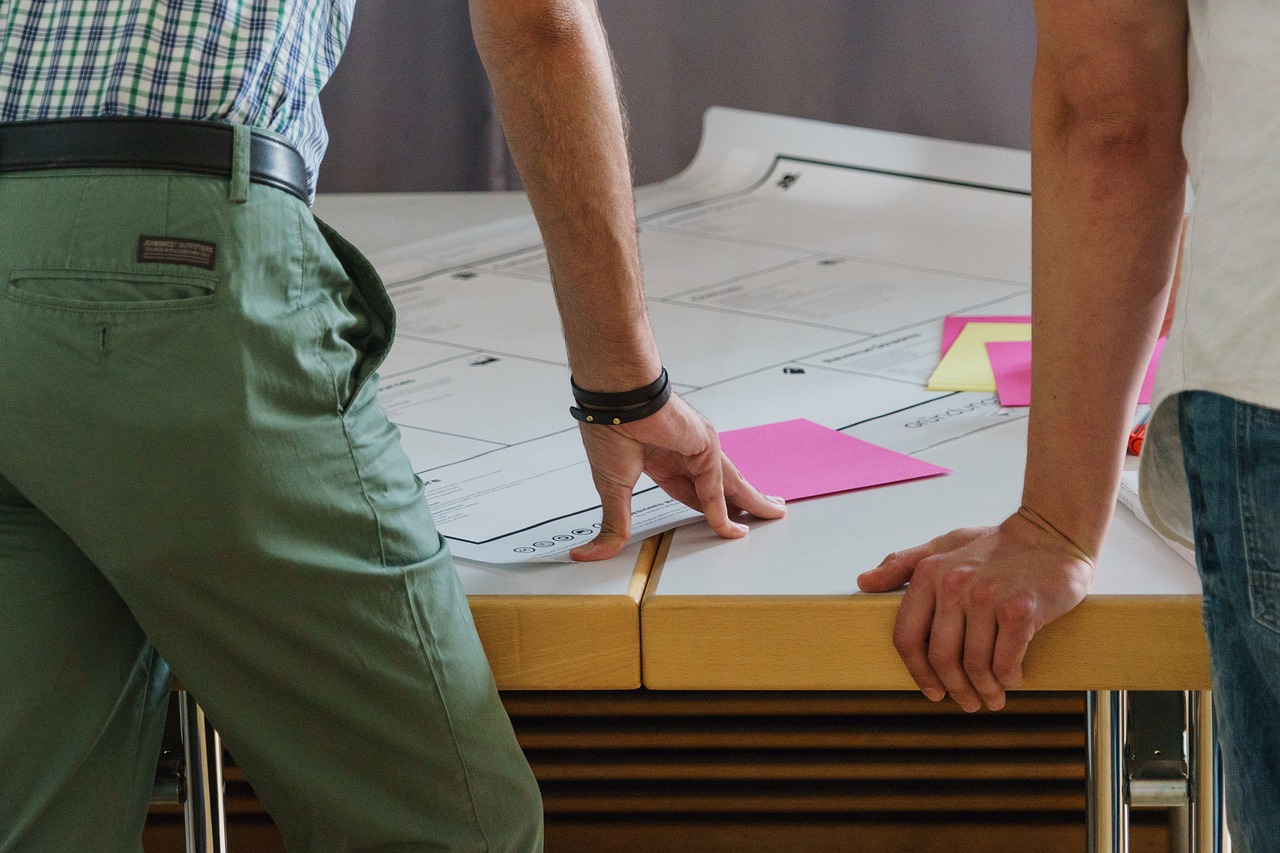In “Understanding User Needs: A Guide to Design Thinking,” you’ll explore the powerful process of design thinking used by teams to tackle complex problems and create innovative solutions. This non-linear and iterative approach is employed by major companies like Google, Apple, and Airbnb to understand user needs and drive innovation. By following the five phases of design thinking – Empathize, Define, Ideate, Prototype, and Test – you’ll be able to explore different perspectives, redefine problems, and create viable solutions. With frameworks like AIGA’s Head, Heart, Hand approach and IDEO’s Inspire, Ideate, Implement process, design thinking provides a versatile toolkit for problem-solving and fosters a deep understanding of user needs.

This image is property of pixabay.com.
Understanding User Needs: A Guide to Design Thinking
Design thinking is a non-linear, iterative process used by teams to understand users, redefine problems, and create innovative solutions. It is a mindset and a problem-solving approach that puts the needs of the user at the center. This article will provide a comprehensive guide to design thinking, including an overview of the process, the benefits it offers, key companies using it, the five phases of design thinking, Stanford University’s design thinking process, different frameworks for design thinking, and common elements of these frameworks.
Overview of Design Thinking
Definition of Design Thinking
Design thinking can be defined as a human-centered approach to problem-solving that emphasizes empathy, creativity, and collaboration. It involves understanding the needs and wants of users, redefining problems, and generating innovative solutions to meet those needs.
Non-linear and Iterative Process
Design thinking is a non-linear and iterative process, meaning that it doesn’t follow a strict linear path from start to finish. Instead, it involves constant iteration and revisiting of previous stages. This allows for flexibility and adaptability as teams gather more insights and learnings throughout the process.
Focus on Understanding Users
One of the key principles of design thinking is its focus on understanding users. Design thinkers are driven by empathy and seek to deeply understand the needs, behaviors, and motivations of the people they are designing for. By gaining a clear understanding of users’ perspectives, designers can develop solutions that truly meet their needs.
Redefining Problems
Design thinking goes beyond just solving existing problems; it also involves redefining problems. By reframing the problem statement, designers can uncover new and potentially more effective solutions. This requires looking at the problem from different angles and challenging assumptions.
Creating Innovative Solutions
The ultimate goal of design thinking is to create innovative solutions. Design thinkers embrace creativity and strive to generate ideas that are fresh, unique, and unexpected. By combining empathy, creativity, and collaboration, design thinkers can come up with solutions that meet user needs in new and exciting ways.

This image is property of pixabay.com.
Benefits of Design Thinking
Fostering Innovation
Design thinking is a powerful tool for fostering innovation. By uncovering unmet user needs and leveraging the creative potential of diverse teams, design thinking can lead to breakthrough ideas and solutions. It encourages teams to think outside the box, challenge assumptions, and explore new possibilities.
Addressing Ill-defined or Unknown Problems
Design thinking is particularly effective for tackling ill-defined or unknown problems. Traditional problem-solving approaches often struggle with problems that are ambiguous or lack clear solutions. Design thinking embraces uncertainty and complexity, allowing teams to navigate through these challenges and find novel solutions.
Understanding User Needs
A major benefit of design thinking is its focus on understanding user needs. By conducting research, interviews, and observations, design thinkers gain deep insights into the experiences and pain points of users. This helps in developing solutions that truly address their needs and improve their lives.
Creating Desirable, Feasible, and Viable Solutions
Design thinking ensures that solutions are not only desirable to users but also feasible and viable. Through the iterative process of design thinking, teams can test and refine their ideas, ensuring that they are not only innovative but also technically and economically possible to implement.
Key Companies Using Design Thinking
Google is well-known for using design thinking as a core part of its innovation process. The company places great emphasis on understanding user needs and developing user-friendly products and services. Google’s user-centered approach has resulted in products like Google Search, Gmail, and Google Maps that have transformed the way we interact with technology.
Apple
Apple is another company that has successfully embraced design thinking. Steve Jobs, the co-founder of Apple, famously said, “Design is not just what it looks like and feels like. Design is how it works.” This philosophy has shaped Apple’s approach to product development, resulting in iconic and user-centric products like the iPhone, iPad, and MacBook.
Airbnb
Airbnb is a prime example of a company that leverages design thinking to address complex problems in the travel and hospitality industry. By putting the needs and desires of their users at the forefront, Airbnb has created a platform that allows travelers to find unique and authentic accommodations worldwide.
Advantages of Design Thinking in Driving Innovation
For these companies, design thinking has proven to be a valuable tool in driving innovation. By understanding user needs, challenging assumptions, and fostering a culture of creativity and collaboration, these companies have been able to stay at the forefront of their industries and continuously deliver innovative products and services.
Addressing Complex Problems
Design thinking also enables companies to address complex problems. Whether it’s solving sustainability challenges, improving healthcare systems, or tackling social issues, design thinking provides a structured approach to navigate through complexity and find effective solutions.

This image is property of pixabay.com.
The Five Phases of Design Thinking
Design thinking typically consists of five phases: Empathize, Define, Ideate, Prototype, and Test. These phases are not necessarily sequential, and teams may revisit and iterate on previous phases as they gather more insights and learnings throughout the process.
Empathize Phase
The empathize phase is all about understanding the user. Design thinkers immerse themselves in the users’ world, conducting research, interviews, and observations to gain empathy and insight. This phase involves putting aside assumptions and truly listening to the needs, wants, and pain points of the users.
Define Phase
In the define phase, teams synthesize the insights gathered during the empathize phase to gain a deep understanding of the problem. They analyze and reframe the problem to ensure that it addresses the true needs of the users and identifies opportunities for innovation.
Ideate Phase
In the ideate phase, teams generate a wide range of ideas and potential solutions. This phase encourages brainstorming, divergent thinking, and wild ideas. The focus is on quantity rather than quality, as the aim is to explore as many possibilities as possible.
Prototype Phase
In the prototype phase, teams bring their ideas to life. They create low-fidelity prototypes that represent their solutions in a tangible form. Prototypes can range from simple sketches to physical models, and they serve as a way to test and gather feedback on the concept before investing in full-scale development.
Test Phase
The test phase is where teams gather feedback and insights on their prototypes. They gather input from users and stakeholders, evaluate the strengths and weaknesses of the solutions, and iterate based on the feedback received. This phase allows for refinement and improvement before finalizing the solution.
Iterative Nature of the Process
It’s important to note that design thinking is an iterative process. Teams may cycle through the phases multiple times, refining their understanding of the problem, generating new ideas, and creating improved prototypes. This iterative nature allows for constant learning and improvement throughout the design journey.
Stanford University’s Design Thinking Process
Stanford University’s d.school has developed its own design thinking process, consisting of five stages: Empathize, Define, Ideate, Prototype, and Test. This process is widely used and has influenced many organizations and practitioners.
Overview of Stanford’s Approach
Stanford’s design thinking process starts with empathy, focusing on understanding the users and their needs. It then moves on to defining the problem, generating ideas, prototyping potential solutions, and finally testing and refining those solutions.
Empathize Stage
The empathize stage of Stanford’s process involves conducting research, interviews, and observations to gain a deep understanding of users. This phase is about listening and observing without judgment, and it lays the foundation for the rest of the process.
Define Stage
In the define stage, teams synthesize their research findings and develop a clear problem statement. This phase is crucial in ensuring that the problem statement is well-defined and aligned with the needs and desires of the users.
Ideate Stage
The ideate stage is all about generating a wide range of ideas and potential solutions. Teams use brainstorming techniques, sketches, and other creative methods to unleash their creativity and explore different possibilities.
Prototype Stage
In the prototype stage, teams turn their ideas into tangible representations. They create low-fidelity prototypes that can be quickly built and tested. This allows for early feedback and helps teams to visualize and communicate their concepts effectively.
Test Stage
In the test stage, teams gather feedback on their prototypes from users, stakeholders, and other relevant parties. They evaluate the usability, desirability, and viability of their solutions and use the feedback to iterate and refine their designs.

Different Frameworks for Design Thinking
There are multiple frameworks and approaches to design thinking. Some of the popular ones include AIGA’s Head, Heart, Hand approach, IDEO’s Inspire, Ideate, Implement process, and the Design Council’s Double Diamond model. Each framework offers its own unique perspective and set of tools for approaching design challenges.
AIGA’s Head, Heart, Hand Approach
AIGA, the professional association for design, proposes a framework with three core components: Head, Heart, and Hand. The Head represents the importance of research, analysis, and problem-solving. The Heart highlights the significance of empathy, understanding, and connecting with users. The Hand emphasizes the practical aspect of design, involving prototyping, testing, and implementation.
IDEO’s Inspire, Ideate, Implement Process
IDEO, a global design company, has developed a framework that consists of three phases: Inspire, Ideate, and Implement. The Inspire phase is about gathering inspiration, insights, and knowledge from various sources. The Ideate phase focuses on generating ideas and exploring different possibilities. The Implement phase is where ideas are turned into reality through prototyping, testing, and implementing solutions.
The Design Council’s Double Diamond Model
The Design Council, a UK government organization, uses the Double Diamond model to illustrate the design thinking process. It consists of four distinct phases: Discover, Define, Develop, and Deliver. The Discover phase involves research, observation, and problem framing. The Define phase focuses on synthesizing insights, defining the problem statement, and ideating potential solutions. The Develop phase involves prototyping and refining solutions. Finally, the Deliver phase is where the solution is implemented and evaluated.
Comparison of Different Frameworks
While these frameworks have their own unique approaches, they share common elements such as empathy, ideation, and prototyping. It’s important to choose the right framework based on the specific needs of the project, the team’s expertise, and the desired outcomes.
Choosing the Right Framework for the Project
When selecting a framework for a design thinking project, it’s essential to consider the project’s complexity, timeline, and goals. Some frameworks may work better for highly ambiguous or unknown problems, while others may be more suitable for projects that require quick turnarounds. It’s also crucial to consider the team’s familiarity and comfort with the chosen framework to ensure a smooth and effective execution.
Common Elements of Design Thinking Frameworks
While different frameworks have their own unique approaches, there are several common elements that can be found across various design thinking frameworks.
Starting with Empathy
Empathy is a foundational element of design thinking. Understanding users’ needs, motivations, and pain points through research, observation, and engagement is essential for creating user-oriented solutions. Empathy allows designers to gain a deep understanding of users and develop solutions that truly meet their needs.
Reframing the Problem
Design thinking involves reframing the problem to identify new perspectives and opportunities. By challenging assumptions and looking at the problem from different angles, designers can uncover innovative solutions that may have been previously overlooked.
Divergent and Convergent Thinking
Design thinking encourages both divergent and convergent thinking. Divergent thinking is the process of generating a wide range of ideas and possibilities, while convergent thinking involves evaluating and selecting the most promising ideas. By balancing these two types of thinking, designers can explore creative solutions while also making practical decisions.
Creating and Testing Prototypes
Prototyping is a key element of design thinking. It involves creating low-fidelity representations of ideas and concepts to gather feedback and test their feasibility. Prototyping allows designers to quickly iterate and refine their solutions based on user feedback and insights.
Iterating and Refining Solutions
Design thinking is an iterative process that involves constant learning and improvement. Designers cycle through the various stages, refining their understanding, generating new ideas, and iterating on their prototypes. This iterative nature ensures that solutions are continuously improved and refined based on user feedback and changing needs.
Incorporating User Feedback
User feedback is an integral part of the design thinking process. Designers actively seek input from users, stakeholders, and other relevant parties throughout the process. User feedback helps in evaluating the effectiveness and desirability of solutions and guides further iterations and refinements.
By incorporating these common elements into their design thinking process, teams can ensure that the solutions they create are user-centric, innovative, and effective.
In conclusion, design thinking is a powerful approach to problem-solving that focuses on understanding users, redefining problems, and creating innovative solutions. It fosters innovation, addresses ill-defined problems, and ensures solutions are desirable, feasible, and viable. Major companies like Google, Apple, and Airbnb have successfully embraced design thinking to drive innovation and solve complex problems. The five phases of design thinking, including empathize, define, ideate, prototype, and test, provide a structured framework for teams to navigate through the process. Stanford University’s design thinking process, along with different frameworks like AIGA’s Head, Heart, Hand approach, IDEO’s Inspire, Ideate, Implement process, and the Design Council’s Double Diamond model, offer additional insights and tools for approaching design challenges. Regardless of the chosen framework, design thinking requires starting with empathy, reframing the problem, employing divergent and convergent thinking, creating and testing prototypes, iterating and refining solutions, and incorporating user feedback. By following these principles and practices, design thinkers can create innovative solutions that truly meet user needs.

